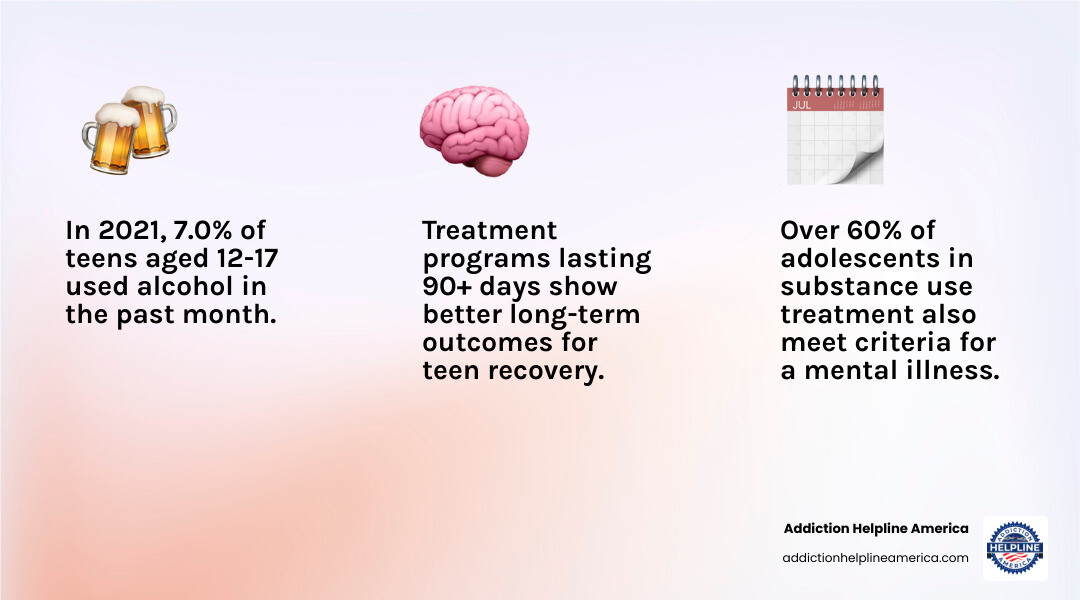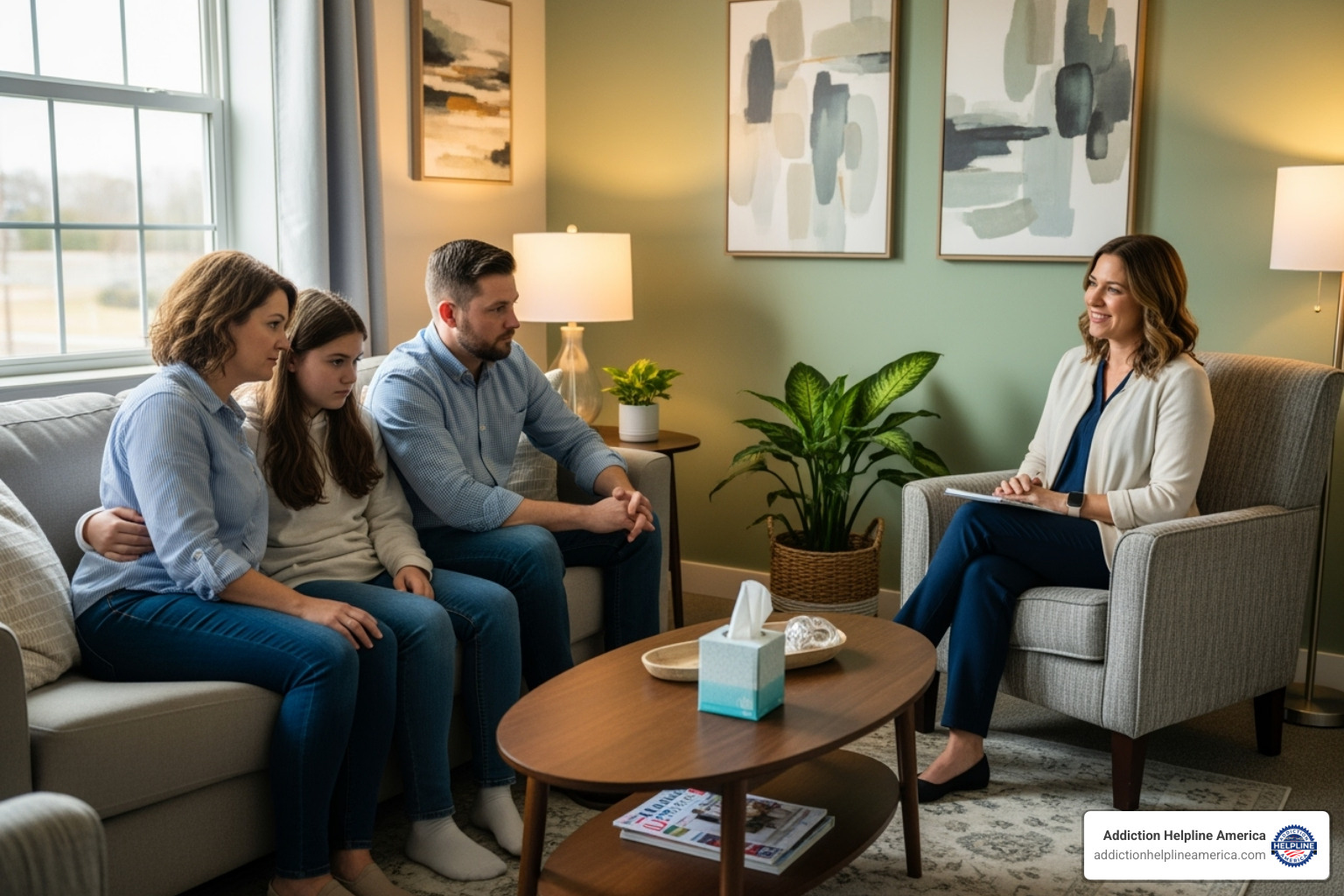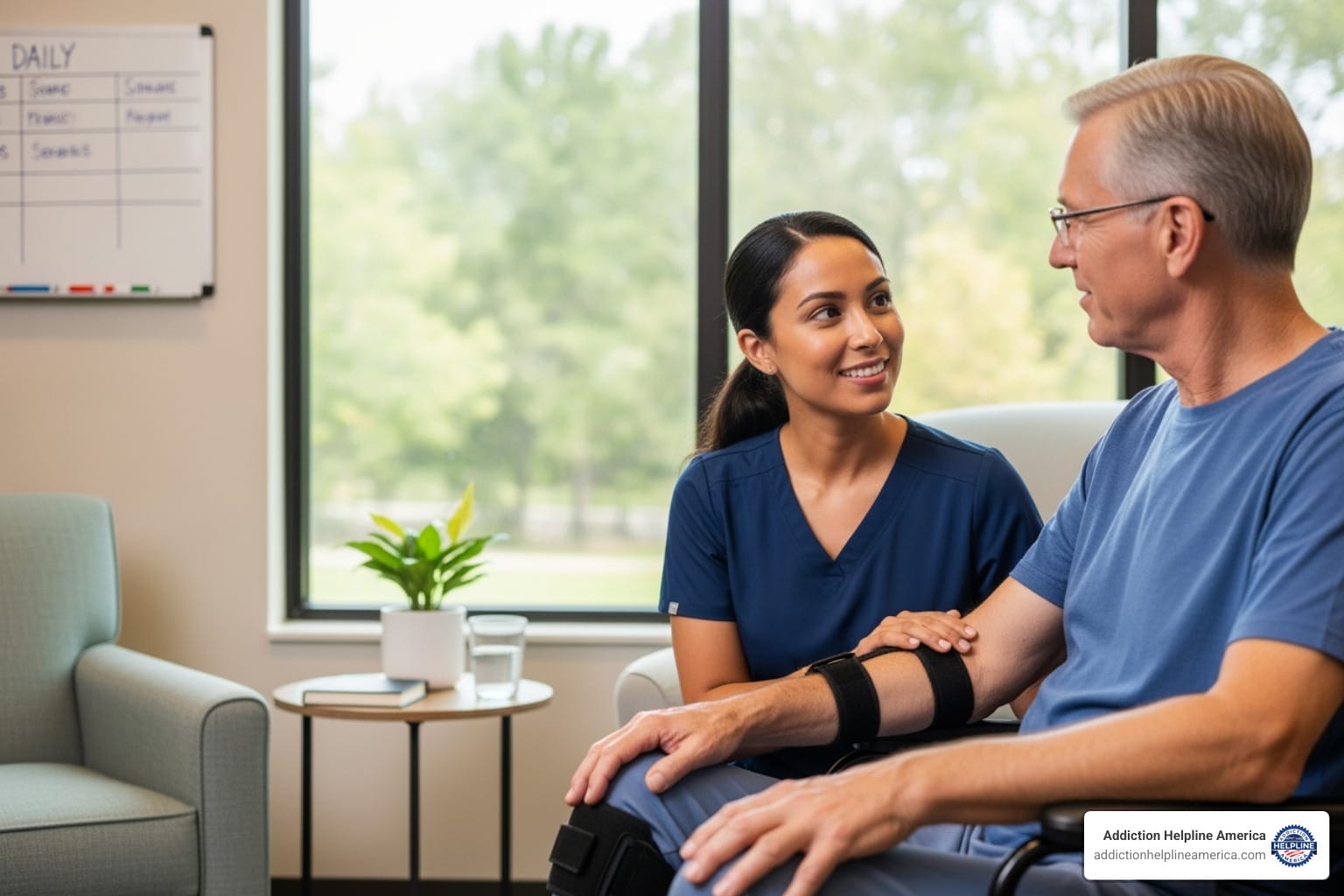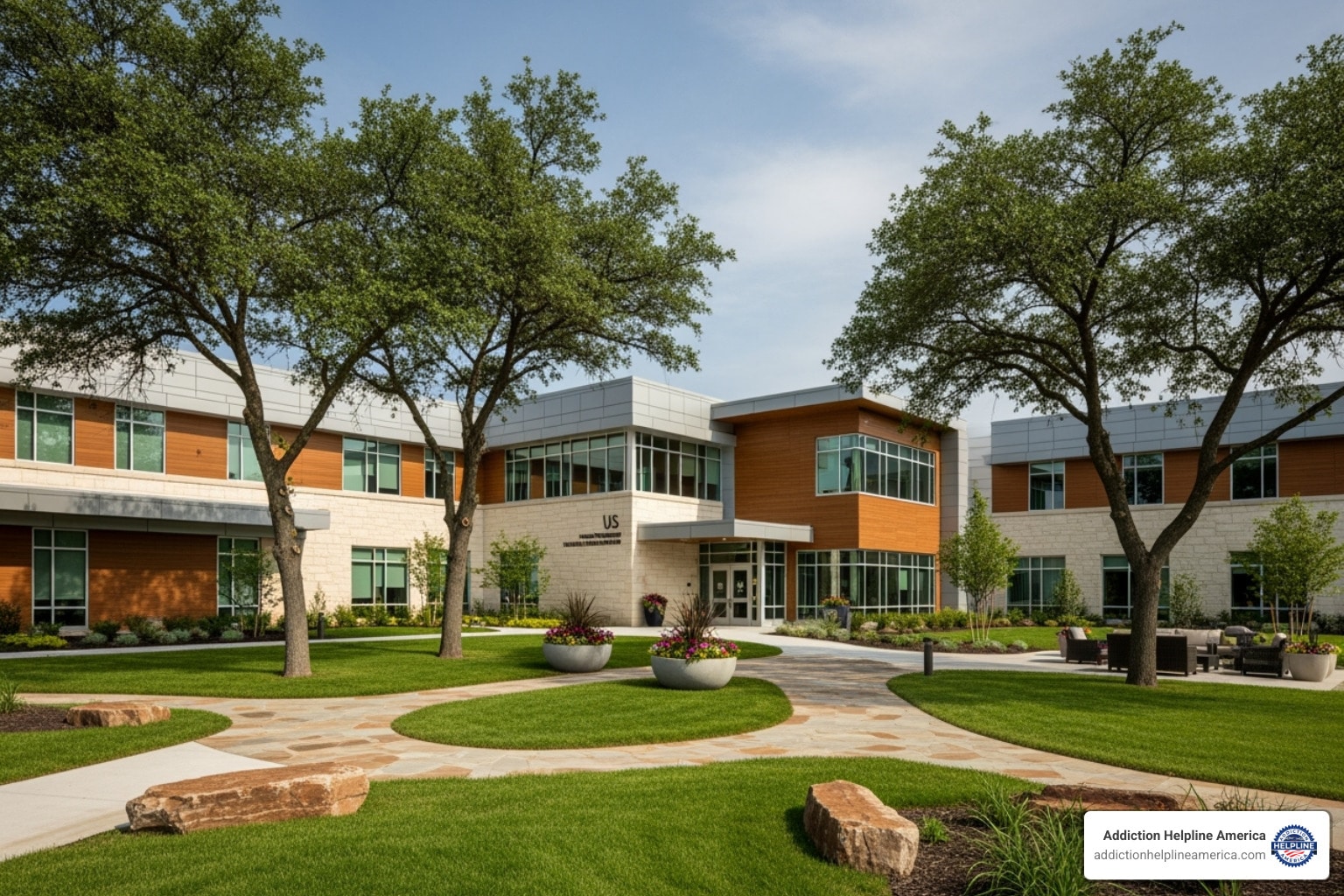
Understanding Teen Rehab: When Your Child Needs Professional Help
Rehabs for teenagers offer specialized addiction treatment for adolescents aged 12-17 struggling with substance abuse and co-occurring mental health issues. Unlike adult programs, they provide age-appropriate therapies, academic support, and family-centered care custom to the unique developmental needs of teens.
Key options include inpatient/residential care for severe addiction, flexible outpatient programs, and specialized tracks like wilderness therapy or dual diagnosis treatment. Programs typically last 30-90 days, though longer stays can improve outcomes.
Statistics show a significant need for this care. In 2021, 7.0% of teens aged 12-17 used alcohol, and over 60% of adolescents in treatment also have another mental illness. Teen addiction often stems from peer pressure, trauma, or stress, and their developing brains make them especially vulnerable.
Deciding to seek help is difficult, but early intervention is key to long-term success. At Addiction Helpline America, we guide families to find appropriate rehabs for teenagers. With the right support, teens can recover and build a resilient, healthy future.

Recognizing the Need for Help: When to Consider a Teen Rehab Center
As a parent, it’s challenging to distinguish typical teenage behavior from signs of a serious problem. While moodiness and a desire for privacy are normal, look for patterns of behavior that represent a significant, negative change in your child. Recent data shows 7.0% of teens aged 12-17 used alcohol in the past month, a reminder that many families face this struggle.
Key Warning Signs
Look for consistent patterns across these areas, not just isolated incidents.
Behavioral Signs:
- Increased Secretiveness: Guarding their phone, being vague about their whereabouts, or becoming defensive when asked simple questions.
- Changes in Friendships: Abandoning long-time friends for a new, often older or riskier, crowd.
- Academic Decline: A sharp drop in grades, skipping classes, or a total loss of interest in school.
- Loss of Interest: Quitting hobbies, sports, or other activities that once brought them joy.
Physical Signs:
- Poor Hygiene: A sudden lack of concern for personal grooming and cleanliness.
- Significant Weight Changes: Unexplained weight loss or gain.
- Bloodshot Eyes or Dilated Pupils: Persistent red eyes can be a direct indicator of substance use.
- Unusual Odors or Fatigue: Strange smells on clothing or in their room, and chronic exhaustion.
Psychological Signs:
- Extreme Mood Swings: Volatility that goes beyond typical teenage emotions, from euphoria to deep despair.
- Increased Anxiety or Paranoia: A new or worsening pattern of anxiety, fearfulness, or suspicion.
- Lethargy and Lack of Motivation: A persistent state of apathy that doesn’t improve with rest.
Co-occurring Disorders
Over 60% of teenagers in substance abuse treatment also have another mental health condition, such as anxiety, depression, or ADHD. This is known as a dual diagnosis. Often, teens use substances to self-medicate underlying emotional pain. Their developing brains are vulnerable, and what looks like defiance may be a cry for help. This is why specialized rehabs for teenagers that treat both conditions are so vital.
When to Seek Help
If several of these signs persist and your attempts to connect are met with hostility, it’s time to seek professional help. Trust your parental instincts. Recognizing the need for help is an act of love that can save your child’s life. Early intervention significantly improves outcomes. For more data, the National Institute on Drug Abuse provides comprehensive statistics.
Why Specialized Teen Addiction Treatment is Crucial

Rehabs for teenagers are not just smaller adult programs; they are fundamentally different approaches designed for the developing adolescent mind and body. Sending a teen to an adult facility can be ineffective and even counterproductive.
Key Differences in Teen vs. Adult Treatment
- Brain Development: The teen brain, particularly the prefrontal cortex responsible for impulse control and decision-making, is still developing until age 25. Substances can disrupt this growth, impacting cognitive function and emotional regulation. Teen-specific therapies account for this vulnerability.
- Peer Influence: Teens are highly susceptible to peer pressure. Specialized programs teach them to build resilience, set boundaries, and form healthy, sober friendships.
- Emotional Needs: Adolescents experience intense emotions. Teen rehabs provide a safe space to process feelings of stress, anxiety, or trauma with therapists who specialize in adolescent development. They learn healthy coping skills instead of using substances to numb their feelings.
- Therapeutic Approach: Teen programs use developmentally appropriate therapies like art, music, and adventure-based activities that engage teens more effectively than traditional talk therapy alone.
- Academic and Family Support: Unlike most adult programs, teen rehabs integrate accredited schooling so students don’t fall behind. They also employ a family-centric approach, with extensive family therapy to heal relationships and create a supportive home environment for a successful return.
The goal is to equip teens with practical life skills and a plan for a hopeful, sober future. Understanding the science of addiction, especially in developing brains, underscores why specialized care is essential. The National Institute on Drug Abuse offers more insight into how drugs affect the brain and behavior.
Exploring the Different Types of Rehabs for Teenagers
Finding the right treatment program means matching the level of care to your teen’s specific needs. Rehabs for teenagers range from intensive, 24/7 residential care to flexible outpatient options. The choice depends on the severity of the addiction, the presence of co-occurring mental health issues, and the stability of the home environment.
Here’s how the main program types compare:
| Feature | Inpatient/Residential Rehab | Outpatient Rehab (IOP/PHP) |
|---|---|---|
| Structure | Highly structured, 24/7 supervision, removed from triggers | Structured sessions, live at home, attend school/work |
| Environment | Therapeutic community, on-site living | Home-based, community engagement |
| Intensity | High (daily therapy, activities, medical supervision) | Moderate to High (multiple sessions per week) |
| Cost | Generally higher | Generally lower |
| Ideal for | Severe addiction, co-occurring disorders, unstable home, detox | Mild to moderate addiction, stable home, strong support system |
| Medical Care | On-site medical staff, medically supervised detox | Referrals for medical care, no on-site detox |
| Academic | Integrated school program | Continue regular school or alternative education |
| Family Role | Regular family therapy and visits | Frequent family therapy, home visits |
| Duration | Weeks to several months (often 30-90+ days) | Weeks to months (flexible) |
Inpatient and Residential Rehabs for Teenagers
Inpatient or residential treatment provides the most comprehensive level of care. Teens live at the facility, which offers a safe, structured environment away from triggers. Key benefits include 24/7 supervision, medical detox to manage withdrawal safely, and a therapeutic community of peers who understand their struggles. These programs are ideal for teens with severe addiction, those who have not succeeded in outpatient settings, or those with significant co-occurring mental health disorders.
Outpatient Treatment Options
Outpatient programs allow teens to receive intensive treatment while living at home and continuing with school. This flexibility allows them to practice coping skills in their real-world environment.
- Partial Hospitalization Programs (PHP): The most intensive option, with treatment programming for most of the day, like a school schedule.
- Intensive Outpatient Programs (IOP): Involve several hours of therapy on multiple days per week, often after school.
- Standard Outpatient: Consists of one or two weekly therapy sessions, suitable for milder issues or as a step-down from a higher level of care.
Specialized Rehabs for Teenagers
Many programs offer innovative approaches to engage teens. Wilderness and adventure therapy use outdoor challenges to build confidence and resilience. Holistic approaches like art or equine therapy provide non-verbal ways to process emotions. Gender-specific programs create safe spaces for boys or girls to address sensitive issues, while dual diagnosis treatment is essential for teens with co-occurring mental health conditions. Learn more about this integrated approach through our dual diagnosis treatment resources.
The best programs offer program flexibility, tailoring the treatment to your teen’s individual needs. Our team at Addiction Helpline America can help you steer these options to find the right level of care.
The Path to Recovery: From Admission to Aftercare
Finding the right rehabs for teenagers is the first step on a life-changing journey. The recovery process is designed to rebuild lives, heal families, and give young people the tools for a sober future.

How to Choose the Right Rehab Program
Choosing a program is a critical decision. Look for these key indicators of quality:
- Accreditation and Licensing: Ensure the program is accredited by a recognized body (like CARF or the Joint Commission) and licensed by the state. This guarantees they meet high standards for safety and care.
- Qualified Staff: The treatment team should specialize in adolescent addiction and mental health.
- Evidence-Based Therapies: The program should use proven methods like Cognitive Behavioral Therapy (CBT) and Dialectical Behavior Therapy (DBT).
- Family Involvement: Quality programs make family therapy and education a central component of treatment.
- Academic Support: Look for accredited educational programs to keep your teen on track with school.
- Aftercare Planning: A great program begins planning for discharge from day one, with a robust relapse prevention and transition plan.
At Addiction Helpline America, we can help you ask the right questions and find a program that fits your teen’s needs.
Navigating Costs and Financial Assistance
Cost should not be a barrier to life-saving treatment. Several options can make care affordable:
- Insurance Coverage: Most private health insurance plans offer benefits for addiction treatment. Facilities can verify your coverage to clarify costs.
- Private Pay and Financing: Many centers offer payment plans or financing options to spread out the cost.
- Sliding Scale Fees: Some programs adjust their fees based on family income.
- Scholarships and Grants: Non-profit organizations and facility funds may offer financial aid.
- State-Funded Programs: These offer low-cost or free treatment, though they may have waiting lists.
Our team can help you explore all financial options. For more details, visit our insurance verification page.
The Importance of Aftercare and Continued Support
Recovery is a lifelong journey that continues long after a program ends. Strong aftercare is crucial for preventing relapse. Key components include:
- Relapse Prevention Planning: Learning to identify triggers and use healthy coping strategies.
- Ongoing Therapy: Continuing individual and family counseling to reinforce skills and heal relationships.
- Support Groups: Peer groups like AA, NA, or SMART Recovery provide community and accountability.
- Sober Living Homes: A structured, supportive environment for teens who need a gradual transition back home.
- Alumni Programs: Staying connected to the treatment community for ongoing support and motivation.
Family involvement remains vital during aftercare to create a home environment that supports long-term recovery.
Frequently Asked Questions about Teen Rehab
Considering rehabs for teenagers brings up many valid questions and concerns. Here are answers to some of the most common ones we hear from parents at Addiction Helpline America.
Can I legally make my teenager go to rehab?
In most states, yes. As a parent or legal guardian, you generally have the authority to consent to medical and mental health treatment for your minor child (under 18), even if they object. Some states have specific involuntary commitment laws for adolescents with severe substance use disorders.
However, forcing a teen into treatment can create resistance. A professional intervention is often a better first step, as it encourages the teen to accept help voluntarily. Involuntary placement should be a last resort, typically reserved for situations where the teen is a danger to themselves or others.
How long does a typical teen rehab program last?
Program duration varies based on the teen’s individual needs, the severity of the addiction, and any co-occurring mental health issues.
- 30-day programs are best for stabilization and initial assessment.
- 60-90 day programs are often considered the standard for effective treatment, allowing enough time for meaningful therapeutic work and skill-building.
- Long-term programs (6+ months) may be necessary for severe addiction or complex trauma.
Research consistently shows that longer treatment durations (90 days or more) lead to better long-term outcomes. The goal is lasting recovery, not just completing a program quickly.
What happens if my teen relapses after treatment?
First, it’s important to understand that relapse is not a moral failure but a common part of the recovery process for a chronic disease like addiction. If a relapse occurs, it’s a sign that the treatment plan needs to be adjusted, not that treatment has failed.
The immediate steps are to:
- Seek professional guidance from the treatment center or a therapist to understand what led to the relapse.
- Reassess the treatment plan. This might mean increasing therapy, adjusting the aftercare plan, or even returning to a higher level of care for a short time.
- Offer continued support. Avoid blame or shame. Your teen needs your love and support to get back on track.
Early intervention can prevent a slip from turning into a full-blown relapse. With patience and professional help, your teen can learn from the setback and strengthen their recovery.
Conclusion: Taking the First Step Towards Healing
If you are exploring rehabs for teenagers, you are likely facing an incredibly difficult challenge. Please know that you are not alone, and there is real hope for healing.
Addiction is a treatable disease, not a character flaw. Specialized teen treatment is essential because the adolescent brain is uniquely capable of healing and adapting with the right support. From intensive residential care to flexible outpatient programs, there is a path that fits your family’s needs.
Early intervention dramatically improves the chances of long-term recovery. The sooner you act, the sooner your child can begin building a healthy, sober future.
At Addiction Helpline America, we provide free, confidential guidance to connect you with the right program. Taking the first step is the hardest part, but it can change everything. Your teenager’s story does not have to be defined by addiction.
Find a teen rehab program today and begin your family’s healing journey. We are here to help you every step of the way.
Our helpline is 100%
free & confidential
If you or someone you care about is struggling with drug or alcohol addiction, we can help you explore your recovery options. Don’t face this challenge alone—seek support from us.
Programs
Resources
Will my insurance
cover addiction
treatment?
We're ready to help
Find the best
drug or alcohol treatment
center
Are you or a loved one struggling with addiction? Call today to speak to a treatment expert.













